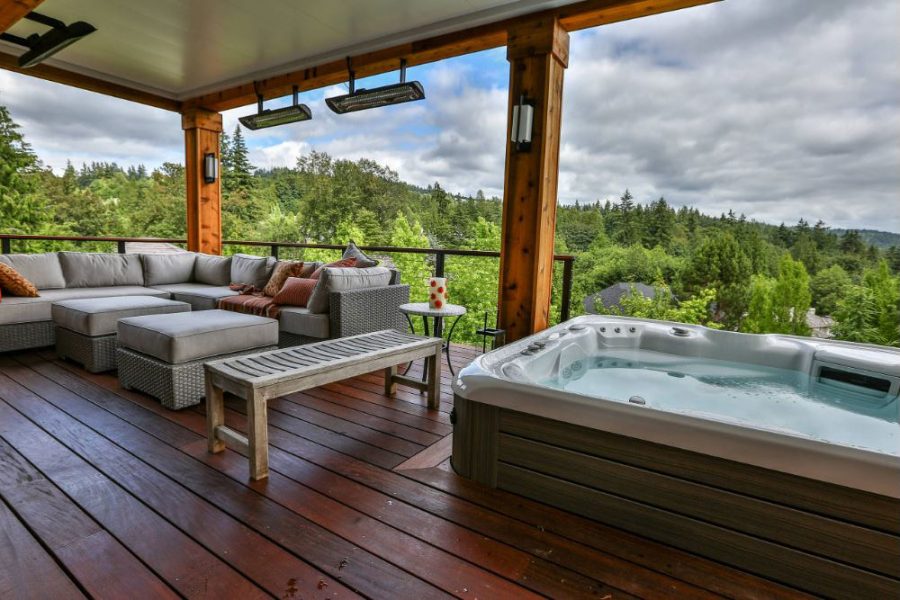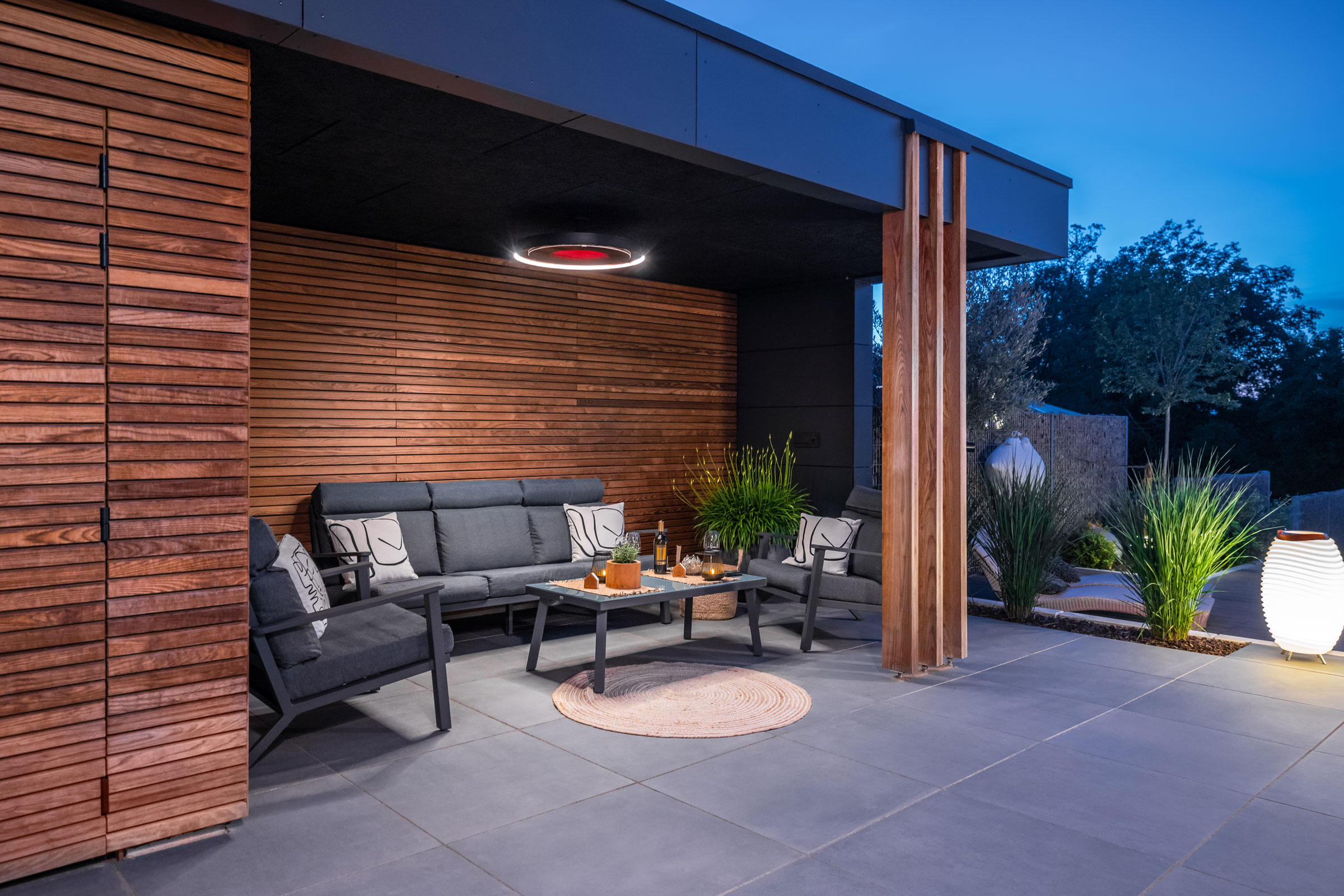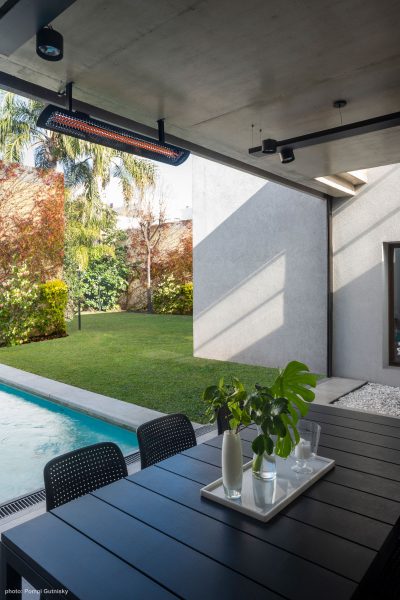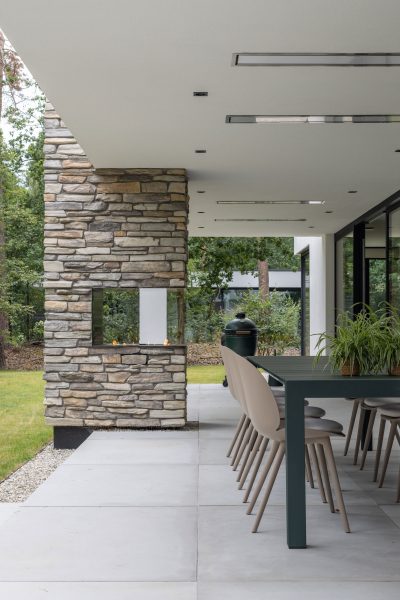Story at a glance:
- Across workplace, hospitality, and residential, large outdoor spaces are now a must.
- Outdoor heating increases the utility of spaces year-round when high-efficiency radiant heat technology is used.
- Zoning, scheduling, and dimmability of heating sources furthers efficiency.
As more and more people want to be outside for all types of activities in all kinds of spaces across four seasons, it’s important to design so people feel comfortable staying awhile, according to Brian Vitale, co-managing director of Gensler Chicago. He and his team often ask: How do you design outdoor experiences that are comfortable and inviting?
“We know from research that just having a view of nature and the outdoors improves people’s well-being, their capacity to think and be productive, and improves their overall mood. Being able to access outdoor space—a function that is one of the highest-ranking amenities a building can offer—increases these outcomes exponentially, even in cold weather climates, and thus makes properties more desirable and thus easier to lease, higher rents, and better performance,” Vitale says. “If you are a part of a campus, a variety of large and small spaces is typically easy to achieve and expected, but in an urban context, any outdoor space, even the smallest of areas, will improve the well-being of its users and see heavy use.”
Vitale says comfort and security are major factors in designing successful outdoor spaces. From providing shade in the summer to allowing enough sun to wash over a space in the winter, the right placements make a space more usable year-round. “You must also build a variety of seating options, not unlike a workspace, into the design of outdoor space. Areas for groups to gather to eat lunch together or hold a meeting are paired with places where people can be alone to recharge or just people-watch,” he says. “We also focus on the outdoor ‘ceiling’ or the variety of datum lines that compress and expand outdoor space. This is achieved with different types of tree canopy heights (where one might circulate versus where one would sit to have a meal), outdoor structures, and even, of course, lighting canopies. This variety makes the outdoor space more comfortable for the users and enhances their experience.”
Outdoor Living Rooms

Outdoor heating increases the utility of spaces year-round when high-efficiency radiant heat technology is used. Zoning, scheduling, and dimmability furthers efficiency. Photo courtesy of Bromic
Vitale says outdoor spaces are increasingly having the comforts of indoors, from highly functionable furniture that make it easy for people to work or socialize to outdoor kitchens and technology like video screens. “Large spaces to gather with a crowd to watch a game together, easy access to food and beverage, and flexible seating are becoming the norm even in colder winter climates,” he says. “We have the capabilities through different heating strategies to keep people comfortable, making this strategy applicable 365 days a year.”
As the line between indoors and out continues to blur, manufacturers have seen the need for solutions to make more comfortable spaces year-round, too. “Demand’s at an all-time high. Restaurants, hotels, and high-end luxury residential properties traditionally have always wanted this solution, but now we’re seeing new spaces we’ve never seen before,” says Blake Petty, commercial specification lead at Bromic Heating. “People are trying to heat outdoor workspaces because—especially now with technology, you’re not stuck in a cubicle in your office. You can take that meeting or call outside.”
Even in Chicago Vitale says people are committed to being outside as much as possible. They just dress for it and go where they know will be comfortable. “There really has been no pushback in this climate to outdoor space. There’s no one who says, ‘Why do we need outdoor space? Just give me a sealed up building, and I’ll be fine.’ They all want to have access to the outdoors.”
People want to be comfortable, and they want to be able to use those spaces year-round.
Both Vitale and Petty have seen universities increasingly demand outdoor spaces that act as year-round community spots to gather. Multifamily projects, too, want not just the ability to heat communal spaces but individual patios. “People who can’t necessarily afford to buy the house with the yard still want a private outdoor space, and they want to be able to use that year-round. Now with technology and multiple manufacturers investing in this space, there are solutions that didn’t necessarily exist for them 10 or 15 years ago,” Petty says.
Hot Options
- Manufacturers like Bromic are reducing energy footprints with flexible heating solutions. Photo courtesy of Bromic
- Bromic offers an opportunity to heat spaces more efficiently, too, with the capability of zone heating. Photo courtesy of Bromic
Bromic’s infrared outdoor heaters in gas, electric, and portable models are one solution helping to make spaces comfortable year-round—and more efficiently, with the capability of zone heating.
The outdoor heaters balance heat output, light output, and energy extended, and intelligent design lets you direct heat exactly where needed. Consider a restaurant, where in the past you may have had 15 propane-powered mushroom heaters on a patio. “You had to turn them all on to start the shift and wait for people to show up. Now you’re heating this entire patio and you’re burning fossil fuels. With zone controlling and electric infrared, at the flip of the switch the heater’s on and it’s at full power within 30 seconds,” Petty says.
Heating and cooling indoor spaces at all times, even when not in use, can be extremely wasteful. Outdoor spaces with added outdoor heating solutions can be separated into zones so heaters will only be turned on in areas where people are, contrary to indoor commercial spaces that often have just a single HVAC system constantly running.
Zone heating, scheduling, and timers as well as dimmability make for much more efficient heating. And now you don’t have to depend on people remembering to turn heat off or on at all. “We are focusing the heat where it’s intended,” Petty says. “With a traditional convection heating system you’re heating the entire building regardless of who’s in it, when, and where. With infrared heating it’s spot heating.”
Petty likens Bromic’s infrared heating, which uses parabolic reflectors to direct the heat on to a target, to a flashlight; you point the light where it needs to go. “It’s a much more efficiently designed product so maybe you don’t use nearly as many heaters and you can directionally focus where it’s needed.”
In October Bromic unveiled its new line of controls, which includes the ability to turn heaters on/off remotely, dim heaters, set timers, schedule functioning hours, create heating zones, and more. The app-based control gives people even more flexibility and comfort. “It has a control modular or box that the heater is wired into and then from your phone or smart device there’s a Bromic app. You have complete control of all your heaters—from scene setting to timing to dimmable control with electrical heaters.”
It’s a huge perk in commercial or rental properties, as you can turn off heaters when no one is there. “We are the only manufacturer to have our own app-based controls. Some of the others rely on a third party and you have to buy another accessory to have those communicate.” It integrates seamlessly with other building or home automation systems, too.
Outdoors is Here to Stay

Bromic’s infrared heating uses parabolic reflectors to direct the heat on to a target so you can focus where it’s needed. Photo courtesy of Bromic
While Covid drove people outside, Vitale says much of the demand for outdoor spaces was already happening. The pandemic just heightened the need. “Although we were doing this before, it made it much more commonplace—and not only commonplace, but people were starting to really request it so we had to have outdoor spaces.”
Petty agrees that the pandemic, while terrible, opened up a whole new world, and the demand for outdoor spaces is here to stay. “Outdoor spaces are no longer an afterthought. You can no longer just stick some pergola structure on the side of a building,” he says.
The line between indoors and out will continue to blur, too, he says. “People want to be comfortable, and they want to be able to use those spaces year-round. Start thinking about how you properly cool them in the summertime and how you can properly heat them in the wintertime.”



